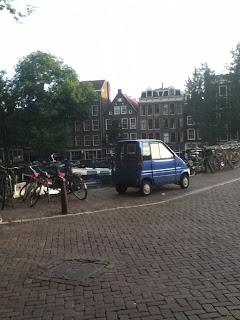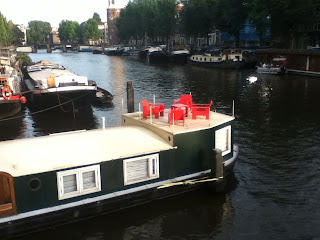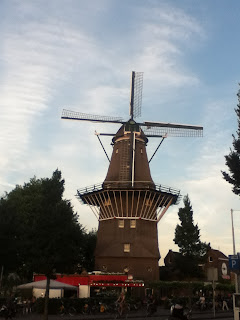This year's LERU Bright Conference (2012) was held in Amsterdam, and I was happy to have the first chance to visit this area. We stayed at the StayOK hostel in Zeeberg, a clean and friendly place which has beds for around 34 Euros/Night including breakfast. Our hosts from the University of Amsterdam and Amsterdam University College (a joint venture with the University of Amsterdam) were very accomodating and provided us with bicycles to travel to the various events during the week. We first met in the old University of Amsterdam Auditorium, which appeared to be an old church. We heard from Professor Dymph van den Boom who gave us her insight into the nature of research: "The more you discover, the more you learn how much is left to uncover". Of all the speeches we were to receive, this short introduction gave me considerable insight into the nature of knowledge, and was perhaps my favorite. Next a speech by Richard Rogers classified the phases of Internet usage from the user's perspective. We moved into an adjacent area where we had a reception.
On Tuesday we biked over to Amsterdam University College (AUC, see photo below), gardens still under construction, and heard a CS professor named Peter Sloot. This was a very interesting presentation regarding network graphs, and he gave particular examples from epidemiology. We had our first meeting with our working groups--mine was community--and later took a break for lunch. By Thursday the working groups' goal was to create a 10 minute presentation and a working group paper combining our understanding of network theory to practical social problems. After lunch we heard from Prof. Maarten van Steen who introduced examples from crowd movement and dating. We had dinner at AUC and were later escorted around Martin Luther King Park for a traveling festival. This group or artists, musicians and performers had a number of simultaneous shows and events including a minibus concert titled Virus. The idea was to present the nurse with your symptoms after which you received a musical prescription--you then went into the minibus where you received a live musical "treatment". Another well-attended favorite was the "silent disco" in which each dancer had their own headphones, and outsiders watched the action without hearing anything!
Wednesday began with a talk by Harry van Dorenmalen on the importance of networking for ones' career. Most of the day was spent polishing the presentations and preparing for their delivery the following day. At the days' end we were treated to a classical music concert which was part of the Grachtenfestival. Daria van den Bercken, the Navarra String Quartet, Pianoduo Scholtes & Janssens, and Sax & Stix each played very different and interesting pieces. Sax & Stix took the prize with their innovative combination of soprano and alto sax (played alternatively by talented Eva van Grinsven) and various percussion instruments ranging from a marimba to timbales and a small bell (played by a Ramon Lormans).
Thursday featured our 11 working panel presentations and a talk by Prof.Jan van Dijk of the Universite of Twente. His talk was very informative and highlights increasing disparity within the society due to the lack of internet access and other factors. He made the important point about controlling one's own online experience by asking: "why can't we control the internet?". He was the first in the conference to classify the internet as a "complex adaptive system", and described a number of principles (laws) that govern the development of the system. (only two shown below)
- Limits of Attention
- Amplification
 |
| University of Amsterdam |
 |
| Very Small Car |
 |
| Canal Boats make a cool spot for impromptu gatherings. Note the striking design. Netherlands hosts a number of clever and innovative buildings and public works. Canals were first built from the 13th century to repel invaders. |
 |
| Narrow Row houses |
 |
| Windmill with a pub below. |
 |
| Amsterdam University College has around 700 students, and allowed us to be the first in their new building, across the street from the University of Amsterdam in Science Park. The exterior panels resemble wood but appear to be iron with a rich red oxide. |
|
 |
| Concrete "Social Sofa" for anyone to sit on, bordering Prins Hendrik Kade |
